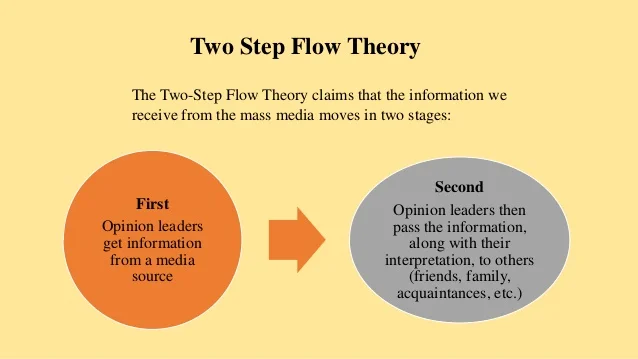Ever wondered how a meme goes viral overnight? Or how a new product becomes a sensation? It’s not just random chance. Behind the rapid spread of ideas and trends lies a powerful phenomenon known as the “two-step flow theory.” This theory provides a framework for understanding how information travels from its source to the masses, explaining the complex dance between opinion leaders and the wider public.

Image: www.researchgate.net
In simple terms, the two-step flow theory suggests that information doesn’t flow directly from the source to everyone. Instead, it travels through a network of individuals, with opinion leaders playing a crucial role in disseminating information and shaping public opinion. These opinion leaders, often regarded as experts or influencers in a particular field, act as intermediaries, filtering and interpreting information before it reaches the wider audience.
The Birth of a Theory: A Historical Journey
The two-step flow theory emerged in the 1940s, fueled by the rise of mass media and the need to understand how people form opinions in a rapidly changing world. Paul Lazarsfeld, Bernard Berelson, and Hazel Gaudet, in their groundbreaking study of the 1940 presidential election, observed that voters weren’t directly influenced by radio broadcasts or newspaper articles. Instead, they were more likely to be swayed by the opinions of friends, neighbors, and local leaders.
This research marked a turning point in understanding information dissemination. It challenged the prevailing notion of direct communication from source to receiver and introduced the idea of interpersonal communication as a vital factor in shaping public opinion. The two-step flow theory provided a more realistic and nuanced understanding of how information travels in a society.
Unveiling the Mechanism: Key Concepts
Opinion Leaders: The Bridge Between Source and Audience
Opinion leaders form the heart of the two-step flow theory. These individuals are considered influential figures within their social circles, respected for their expertise, knowledge, or social standing. They actively consume information from media and other sources, process it, and then share their interpretations with their network.
Think of a fashion blogger who reviews the latest trends, a doctor who discusses new health guidelines, or a local politician who shares their insights on current affairs. These individuals act as information filters, translating complex issues into easily digestible information for their followers.

Image: www.slideshare.net
The Influence of Personal Networks: Social Connections Matter
The two-step flow theory underscores the importance of interpersonal networks. Information doesn’t flow in a vacuum. It travels through social connections, influenced by personal relationships, trust, and shared values. This aspect highlights the critical role of social networks in shaping public perceptions.
Think of a group of friends discussing a new movie, a family debating political issues, or colleagues sharing opinions on a new work policy. These interactions are vital in the flow of information and opinion formation.
Two-Step Flow in Action: Real-World Examples
The two-step flow theory is not an abstract concept; it plays out in our daily lives. Consider these real-world examples:
The Viral Spread of a Meme
A funny meme starts circulating online. It first gains traction among a group of friends, then spreads to their networks, and then to a wider audience through social media sharing. Key opinion leaders in online communities might share and amplify the meme, contributing to its viral reach.
The Adoption of a New Technology
A new smartphone is released. Technology enthusiasts and reviewers provide early impressions, influencing their followers’ buying decisions. Based on their recommendations, others in their network are more likely to purchase the new device.
The Success of a Political Campaign
During an election, political candidates try to reach voters through various media channels. However, their message often travels through influential individuals, such as local leaders, community organizers, or prominent figures who endorse their campaign.
Beyond the Two-Step: Evolution and Expansion
While the two-step flow theory offers a valuable framework, it has evolved over time to account for the complexities of modern information dissemination. Current thinking acknowledges that the flow of information is often multi-step, with multiple opinion leaders and influencers potentially shaping public perceptions.
The rise of social media has further diversified the information landscape, leading to a more decentralized model where individuals can act as both opinion leaders and followers simultaneously. This interconnectedness expands the reach and impact of information, leading to a complex web of communication.
Leveraging the Two-Step Flow: Strategic Applications
Understanding the two-step flow theory can be incredibly valuable for marketers, communicators, and anyone seeking to influence public opinion. By identifying opinion leaders relevant to their target audience, organizations can effectively reach a wider network through these influential figures.
For instance, a company launching a new product might partner with influential bloggers or social media personalities to spread awareness and generate positive reviews. This strategic approach can leverage the influence of opinion leaders to boost product visibility and generate word-of-mouth marketing.
Two-Step Flow Theory
Conclusion: A Powerful Lens for Understanding Information Flow
The two-step flow theory remains a cornerstone of understanding information dissemination, providing a valuable lens for analyzing how ideas and trends spread in society. By recognizing the crucial role of opinion leaders and interpersonal networks, we gain a deeper understanding of how information travels and shapes public opinion.
In a world saturated with information, the two-step flow theory reminds us that communication is a complex, multi-layered process. By understanding this theory, we can critically evaluate the information we consume, identify the influencers who shape our perceptions, and navigate the ever-evolving landscape of information flow.






